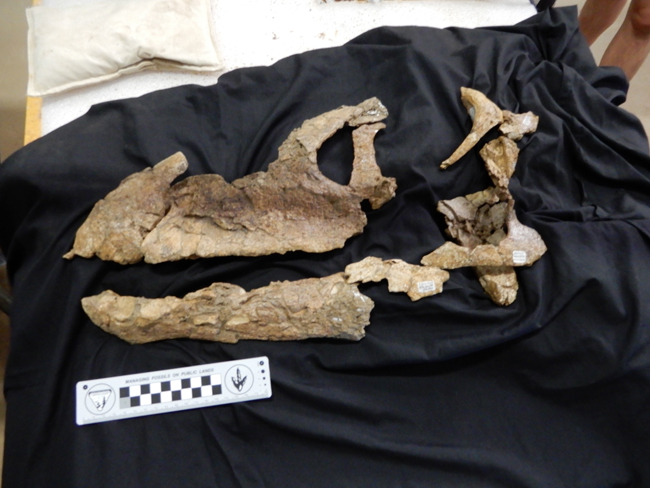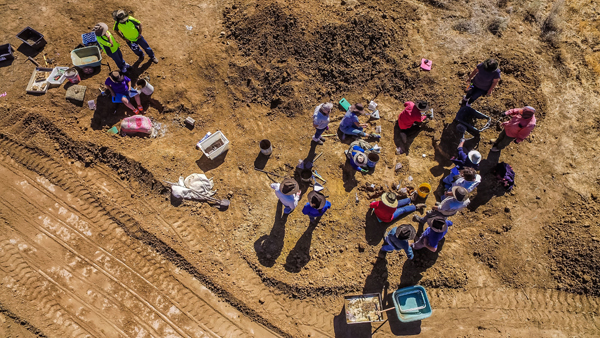Near-complete Titanosaur Skull Found in Queensland
A virtually complete titanosaur skull has been found in Queensland. The fossil discovery is Australia’s most complete sauropod skull found to date. It supports the hypothesis that Australian sauropods originated in South America. The titanosaur skull has been assigned to Diamantinasaurus matildae.

Diamantinasaurus matildae
Australian Age of Dinosaurs Museum researchers in collaboration with Curtin University (Perth) despatched a media release announcing the discovery of the stunning sauropod skull. The fossil specimen, nicknamed “Ann” was excavated in 2018 at a dig site located at Elderslie Station, near Winton (Queensland).
The fossil specimen is believed to be between 98-95 million years old (Cenomanian faunal stage of the Late Cretaceous). It is the fourth specimen of Diamantinasaurus matildae to have been discovered by Australian Age of Dinosaurs Museum staff.
Studying the Skull
Research on the titanosaur skull was led by Museum Research Associate Dr Stephen Poropat, a
Postdoctoral Research Fellow at Curtin University.
Dr Poropat stated:
“This skull gives us a rare glimpse into the anatomy of this enormous sauropod that lived in northeast Australia almost 100 million years ago.”

Implications for Titanosaur Evolution
The researchers identified similarities between “Ann” and the skull of another titanosaur Sarmientosaurus musacchioi. S. musacchioi fossils come from southern Argentina, from rocks which are roughly contemporaneous with the Winton Formation strata. The braincases of these two titanosaurs were similar, along with the dentition (teeth). Similar anatomical characteristics were also identified in the quadratojugal (a bone from the back of the skull near the posterior of the lower jaw).
Dr Poropat commented that their findings support previous theories that sauropods were using Antarctica as a migratory pathway between South America and Australia between 100 and 95 million years ago.
The doctor added:
“Our research suggests that Diamantinasaurus was one of the most ‘primitive’ titanosaurs. Gaining a better understanding of this species might explain why titanosaurs were so successful, across so much of the world, right until the end of the Age of Dinosaurs.”

For models and replicas of titanosaurs and other sauropods: CollectA Deluxe Prehistoric Animal Models.
Titanosaur Skull Links Australian Dinosaurs to Antarctica and South America
At the beginning of the Late Cretaceous (100 to 95 million years ago), the Earth was much warmer than it is today. Antarctica which was located approximately where it is today, was ice free. Australia was much further south and closely associated with the Antarctic landmass. The huge conifer forests of Antarctica might have been an attractive habitat for migratory sauropods. The similarities between “Ann” and Sarmientosaurus skull matieral lends weight to the theory that titanosaurs used Antarctica as a pathway to Australia.
The Diamantinasaurus skull fossils are currently on display at the Australian Age of Dinosaurs Museum.
Everything Dinosaur acknowledges the assistance of a media release from the Australian Age of Dinosaurs Museum in the compilation of this article.
The scientific paper: “A nearly complete skull of the sauropod dinosaur Diamantinasaurus matildae from the Upper Cretaceous Winton Formation of Australia and implications for the early evolution of titanosaurs” by Stephen F. Poropat, Philip D. Mannion, Samantha L. Rigby, Ruairidh J. Duncan, Adele H. Pentland, Joseph J. Bevitt, Trish Sloan and David A. Elliott published by Royal Society Open Science.


